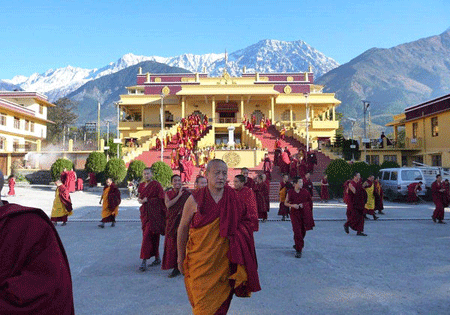
It was a chance encounter on Bondi Beach that would have profound repercussions in the foothills of the Himalayas.
Filmmaker Mark Gould had just directed the documentary Tibet – Blood on the Snow and was looking around for an informed test audience. Enlightened, even.
And there they were, on the sand: a group of red-robed Tibetan monks led by Tibet campaigner and fundraiser Maureen Fallon on an awareness tour of Australia, drumming up money and support for the exiled community in Dharamsala, India.
Gould had his preview crowd and very soon Ms Fallon would have an answer to a perplexing problem among the Tibetans. Why were so many of them suffering painful, often agonising stomach pain?
Chatting after the impromptu preview, Ms Fallon noticed a flyer for a recent production Gould had worked on called The Winners’ Guide to the Nobel Prize, about two Perth medical scientists who had cracked a painful puzzle and won a Nobel Prize for their efforts.
“There was a little poster on my wall of Barry Marshall and Robin Warren and she said, ‘Oh, what’s that?’ and I handed her the DVD,” Gould explained.
Winner’s Guide told the story of Dr Marshall and Dr Warren’s stubborn journey of discovery against a powerful tide of global scientific doubt.
The pair were convinced stomach ulcers were not the product of stress or diet or high levels of stomach acid. Rather, they were the work of an insidious little character they called helicobacter pylori.
Famously Dr Marshall deliberately infected himself – drinking a solution of the bacteria to prove his point. He made himself very ill and all the more determined.
“She said to me, ‘the monks frequently have this condition’,” Gould said.
“She put two and two together and wondered, ‘why am I treating them one at a time here? Why don’t we try and treat them over there where we can treat an entire population, where we can treat the whole monastery?'”
And so a chance meeting became something much more. Serendipity.
Gould, Ms Fallon, her interpreter colleague Sonam Rigzen and a no-nonsense nurse – final-year medical student Courtney Harrington – soon found themselves in the rambling Gyuto monastery in India with a camera, some HB test kits and a firm resolve to crack the tummy problems of the local monks, an affliction they call phowa.
“Over the past 16-odd years, Maureen has always managed to help fix their problems,” Mr Rigzen said.
“One of the common problems is phowa, which is literally translated as stomach, gut disorder.”
Ms Harrington led the testing program which involved drinking a test solution then blowing into breath analysis tubes.
“I am trying to explain to them to drink this urea substance,” she said.
“You get Sonam who is rather a joker and bit of a larrikin saying, ‘bottoms up, boys. It’s the closest you are ever going to get to alcohol!'”
It’s a race against time. The team have 18 days to test the monks, shuttle the kits back to Sydney for analysis and then – if their suspicions prove correct – roll out a treatment program.
“She’s a dynamo, Maureen. She’s an absolute dynamo,” Gould declared.
“She put together a very high-profile medical team in Sydney by friends and connections.”
One of them is Tom Brody, a leading gastroenterologist in Sydney who also wrote the citation for Dr Marshall and Dr Warren’s Nobel application.
“We’d like to know what percentage of those monks are actually infected, what is the success of eradication therapy and … are we really making a difference here?” he said.
“I think if you’re doing a humanitarian act you want to treat those who suffer most. So not a random selection.”
The test kits survive India’s unpredictable courier system, reach the laboratory in Australia and soon the news is in, once Gyuto’s unpredictable internet service stands up long enough to usher in the email.
The majority of the monks are confirmed with helicobacter pylori, some with staggering readings.
“A low count is three,” notes Ms Fallon, reviewing the figures.
“And some of them are 57. That is pretty serious. Serious helicobacter.”
“It is a hell of a helicobacter! Am I right?” jokes Sonam.
Soon serendipity strikes again. Two more Australian medical students – Nick and Vic – roll up to the monastery on motorcycles and the team has the necessary hands to administer and supervise the antibiotic treatment that will bring long overdue relief to an unlikely bunch of ulcer sufferers.
“It’s been life-changing,” declares Courtney Harrington.
“It shows for the first time that all my studying and late nights in the books can actually help someone somewhere and make a little bit of a difference.
“So it is my first taste of actually being able to help someone with medicine. So I love it. I am very thankful!”
And so are the monks.
-Gut Instinct airs on Foreign Correspondent, Tuesday, June 1 at 8:00pm on ABC1.
Author : Steve Taylor
Source : http://www.abc.net.au




